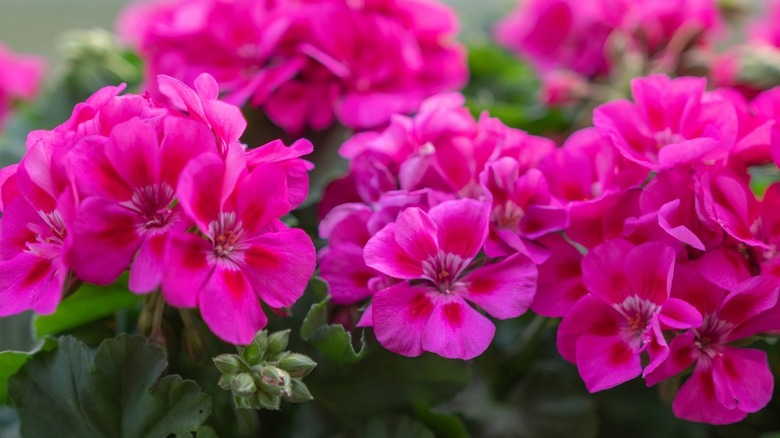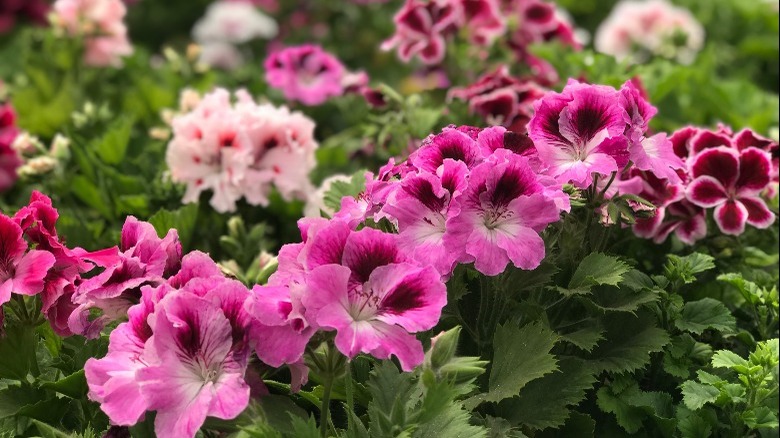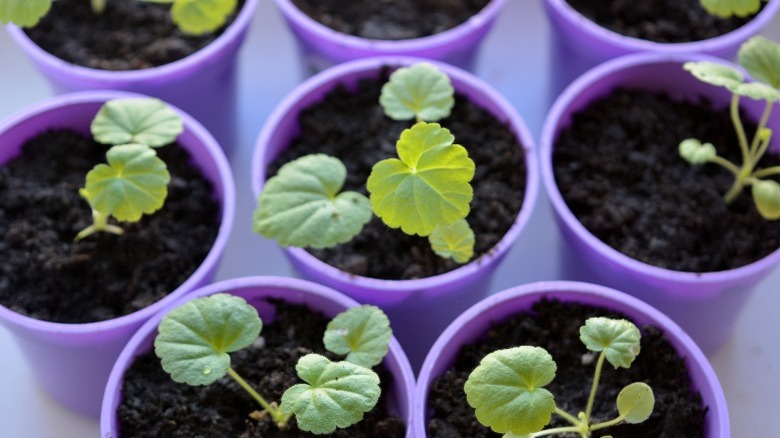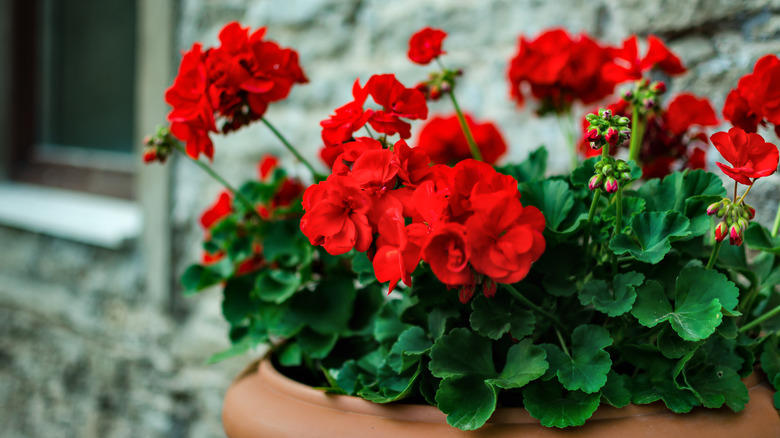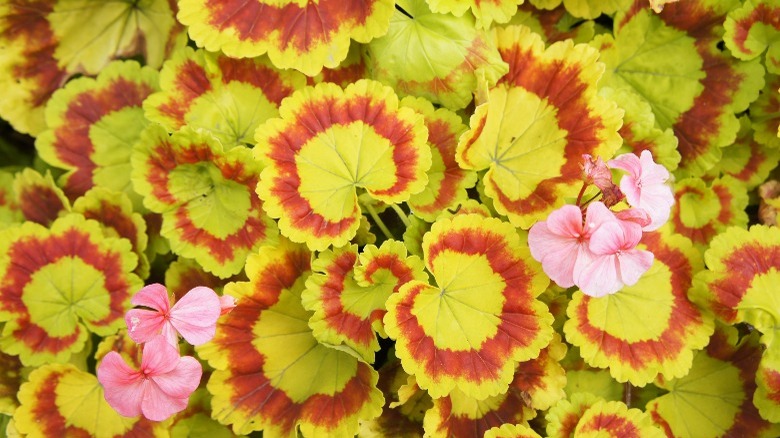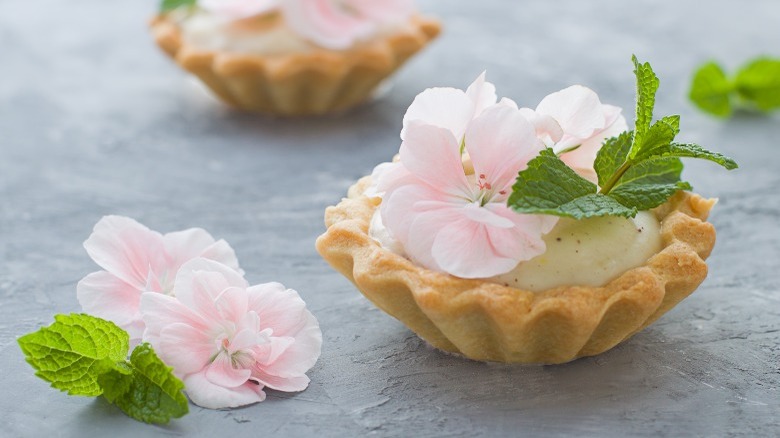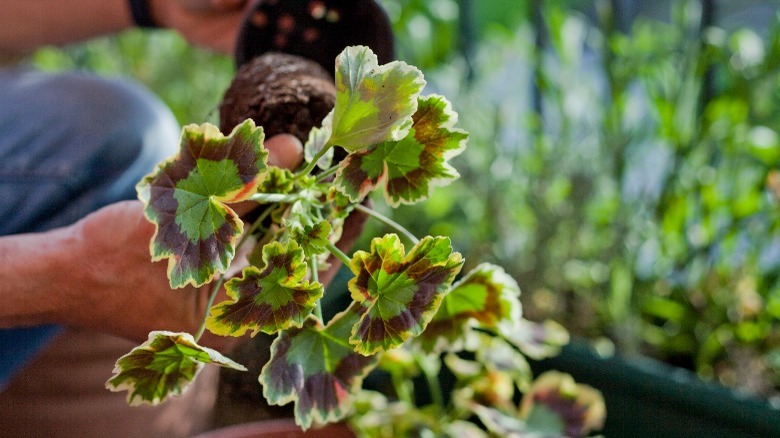Geraniums: Everything You Need To Know Before Planting
Most people have heard of geraniums, and for good reason! These versatile plants are bursting with bold colors and exciting fragrances that add life and beauty to any space they inhabit. Geraniums are actually misnamed, however. According to Southern Living, the title commonly refers to the species Pelargonium, rather than the perennial plants in the genus Geranium, though they both belong to the family Geraniaceae. Nevertheless, there's no confusion about the plant's popularity among new and experienced gardeners alike. Easy to grow outside in garden beds or indoors in containers, the plants provide maximum impact for relatively little care and maintenance. Most variations form neat mounds of roundish ruffled leaves, occasionally variegated or striped with a dark band. Their five-petaled flowers grow in clusters, the colors ranging from soft buttery yellows and pale peach to bright fuchsia and deep violet. They vary in size as well as color, the tallest reaching up to 4 feet tall, while the smallest dwarf varieties stay close to the ground at just 5 to 8 inches tall.
Although they grow wild as perennials in the temperate areas to which they are native, geraniums are only hardy to USDA zones 10 and 11 and are instead grown as annuals in colder climates, as Garden Design explains. They can, however, be brought inside to weather the cold winters and be transplanted back outdoors in the spring. Read on to learn how, and find out even more surprising fact about this wonderful species of flowering plant.
How to use geraniums in garden
With their bright flowers and attractive foliage, geraniums are popular plants that can enhance any garden. Their tidy, mounding shape make them excellent bedding plants, especially when used as garden borders. As annuals, they also make excellent container plants, producing blooms in window boxes or hanging baskets all season long. Certain varieties are fragrant in addition to being beautiful, allowing you to create a multi-sensory garden experience.
Though geraniums are annuals, their life cycle can be extended past the first frost of winter. Before the ground freezes, geraniums can be dug up and either allowed to go dormant, or transferred to pots and encouraged to continue growing indoors as houseplants. Geraniums grown indoors as houseplants generally require more sunlight and more frequent waterings, but generally their care is relatively the same. To overwinter your geranium, you must create unique conditions to coax them into a peaceful dormancy. Start by digging up your geranium, and shaking loose any excess soil, Garden Gate explains. Once the plant has dried out, place upside down in a closed cardboard box or paper bag, and store them anywhere that's cool and dry. You can check on your plant once a month for mold, and if you find that is appears dry, remove and douse the roots in water for a few minutes before returning to storage. To revive your geranium, repot in moist soil six weeks before the last frost date and gradually harden off before spring planting.
How to grow geraniums
Geraniums are versatile plants and can be grown in several ways. Though geraniums can be found in abundance in most garden centers, it's relatively easy and immensely satisfying to grow them from seed. As they are slow-growing, geranium seeds should be sown as early as February to be ready to flower in the spring, according to Gardener's Path. Start your seeds indoors, planting in individual cells or 3 inches apart, in a starter mix. Once the soil is watered, cover the containers with plastic wrap to maintain moisture, and keep them between 60 to 70 Fahrenheit to promote germination. Water whenever the soil appears dry. Once the seeds sprout, remove the plastic and give them 12 to 16 hours of light. After the last frost, you can begin hardening off and get ready to plant in well-draining soil, 12 inches apart for adequate air circulation.
Geraniums can also be easily propagated from cuttings. Select a fresh, green stem, about 5 inches long, with a few leaves. Use a sharp knife to make a clean cut directly below a node, where the new roots will begin to form. Some sources recommend starting cuttings in water before planting, but the delicate roots that develop in water may not be strong enough to adapt to growing in soil. Instead, plant the cutting in fresh, well-draining soil, so that the lowest two nodes are buried in dirt. Water after planting, and keep the soil relatively moist until new roots form.
How to care for geraniums
Geraniums are relatively easy to care for, whether planted in the ground or grown in containers. They are happiest in full sun, receiving at least six hours of light, but certain varieties will do well in partial shade. All geraniums prefer well-draining soil. They should be watered frequently enough to not dry out completely, but not too often, as overwatering can lead to issues such as root rot. When watering, try to douse the soil rather than the foliage, as HGTV warns that geraniums are also prone to fungal diseases caused by excess moisture and decay.
When used as short-lived annuals, their growth cycle centers on producing flowers, and thus their care should follow suit. Geraniums will bloom continuously from late spring until the first frost in winter. To encourage flowering and help prevent the aforementioned fungal diseases, deadhead or remove spent blossoms regularly throughout the season. Regular fertilization will encourage healthy growth. Geraniums are hungry plants, so you can fertilize as often as every two weeks with a diluted solution. Geraniums are also popular as indoor plants, in which case their care takes longevity into account. After some time, they will require repotting and new soil once it has depleted, notes Gardening Know How. Potted geraniums may also require more frequent waterings than those in the ground, as there is less soil to help retain moisture. Fertilize indoor geraniums every few weeks in the growing season, but not as often during the colder months.
Varieties of geraniums
Geraniums are native to South Africa, where many species can be found growing wild. In the 1600s, they were introduced to Europe before spreading further across the globe, per House Beautiful. Today, they are a widely recognized garden and house plant with numerous varieties and cultivars. Geraniums can be categorized into one of six groups: ivy, regal, scented, angel, unique, and zonal geraniums, which are the most common and easily identified by the dark band on their leaves. According to Garden Design, some of the most popular variations include the following:
- Focus Hot Pink Geranium (Pelargonium xpeltatum) is an ivy geranium with neon pink flowers and lush trailing foliage. This variety is excellent for window boxes or hanging baskets where its trailing vines can spill over.
- Rimfire Geranium (Pelargonium "Rimfire") is a regal geranium with large, ruffled flowers made up of deep maroon petals with pink edging. Regal is an apt description indeed!
- Crisped Leaf Geranium (Pelargonium crispum) is a scented variety with white to pink flowers and wavy leaves for which its named. It gives off a lemony fragrance that can help repel mosquitos and other pests.
- Less common than the others mentioned, Darmsden Geranium (Pelargonium Darmsden) is an angel geranium with pink and purple flowers that can grow up to 3 feet tall.
- First Yellow Geranium (Pelargonium xhortorum) is a zonal geranium named for its pastel yellow flowers. This cheerful plant is on the smaller side, reaching just over a foot tall.
Are geraniums toxic?
Geraniums are non toxic to humans, but certain varieties are in fact harmful to pets. Geranium refers to the genus, and plants of the species Pelargonium and its various cultivars are poisonous to cats, dogs, and horses. According to the ASPCA, this species of geranium contains geraniol and linalool, which can cause symptoms such as vomiting, loss of appetite, lethargy, and skin irritation if ingested. The organization advises calling the APCC, or the Animal Poison Control Center, and your local veterinarian if you believe your pet is at risk or has developed symptoms.
Though geraniol and linalool can be fatal to pets, they are also the chemicals that give those geranium species their fragrance. They are concentrated into essential oils for various uses, including citronella to ward off insects. Southern Living explains that different variations of geranium give varying, but commonly recognizable scents. There are geraniums that smell like almond, rose, lime, apple, nutmeg, and even peppermint! Their fragrant leaves and colorful flowers are edible and safe for human consumption, and can be used in a variety of culinary applications. Try incorporating some floral notes to baked goods, or adding some zest to fresh salads.
How to repot geraniums
Geraniums make excellent container plants, and are commonly grown indoors as houseplants. As spring approaches, you may need to start thinking about repotting some of your container plants while the timing is best. Though a rootbound plant is typically considered indicative of neglect, geraniums are an exception, as they actually thrive when slightly rootbound. To figure out if it's time to repot your geranium, look for other signs such as limp foliage, or depleted soil that no longer holds water. The Spruce recommends selecting a new container that is only slightly bigger than the last for a cozier fit. Terracotta or clay pots with drainage holes will allow the plant to dry out between waterings, and help prevent the tightly wound roots from succumbing to rot.
SF Gate suggests cutting back the geranium before repotting in order to encourage new growth, but this step is not necessary. You'll need to be extra careful when handling the plant, as the root ball may be tangled and difficult to pull loose from its current container. To remove excess soil without damaging the root ball, you can try gently rinsing in cool water. Prepare the new container by adding a well-draining, potting soil mixture. Gently place the plant in its new home, filling in any gaps with soil until the entire root structure is covered. It's a good idea to water your plant after repotting to help it adjust to the new container and avoid harmful transplant shock.
